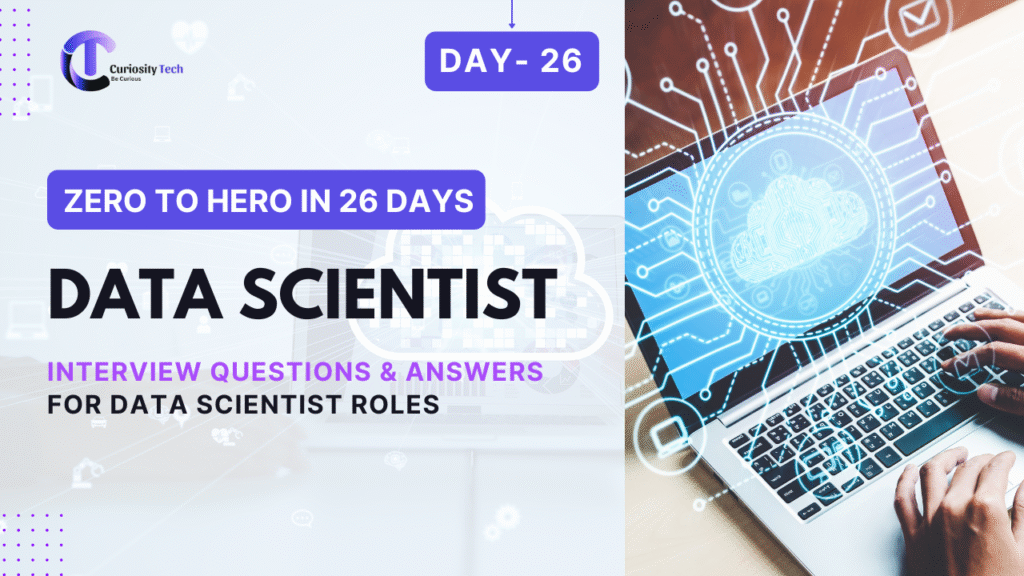Introduction
Securing a data scientist role in 2025 requires not only technical expertise and practical experience, but also interview readiness. Employers evaluate candidates on conceptual understanding, problem-solving, coding, statistical knowledge, ML/AI skills, and business acumen.
At CuriosityTech.in, Nagpur (1st Floor, Plot No 81, Wardha Rd, Gajanan Nagar), learners are trained to face technical interviews, case studies, and scenario-based questions, equipping them with confidence and practical strategies to succeed.
This blog provides a deep-dive guide to common interview questions, model answers, coding examples, and preparation strategies, ensuring a thorough understanding of expectations in 2025 data science interviews.
Section 1 – Core Areas to Prepare
- Programming & Coding: Python, R, SQL, data structures, algorithms
- Statistics & Probability: Hypothesis testing, distributions, regression, Bayesian statistics
- Machine Learning & AI: Supervised, unsupervised, deep learning, NLP, reinforcement learning
- Data Manipulation & Visualization: Pandas, NumPy, Matplotlib, Seaborn, Tableau, Power BI
- Big Data & Cloud: Hadoop, Spark, AWS, Azure, GCP
- Problem-Solving & Business Case Studies: Real-world data interpretation and actionable insights
- Soft Skills & Communication: Explain technical solutions to non-technical stakeholders
CuriosityTech Insight:
Learners practice mock interviews with coding tests, ML problem solving, and business case presentations, ensuring holistic readiness.
Section 2 – Common Interview Questions & Answers
A. Programming & SQL Questions
Q1: Write a Python function to calculate the mean and variance of a dataset.
Answer:
import numpy as np
def mean_variance(data):
mean = np.mean(data)
variance = np.var(data)
return mean, variance
sample_data = [2, 4, 6, 8, 10]
mean, var = mean_variance(sample_data)
print(“Mean:”, mean, “Variance:”, var)
Q2: How do you find duplicate records in SQL?
Answer:
SELECT column_name, COUNT(*)
FROM table_name
GROUP BY column_name
HAVING COUNT(*) > 1;
B. Statistics & Probability Questions
Q3: Explain the difference between Type I and Type II errors.
Answer:
- Type I Error (False Positive): Rejecting a true null hypothesis
- Type II Error (False Negative): Failing to reject a false null hypothesis
Q4: How do you check if a dataset is normally distributed?
Answer:
- Visual methods: Histogram, Q-Q plot
- Statistical tests: Shapiro-Wilk, Kolmogorov-Smirnov
C. Machine Learning Questions
Q5: Explain overfitting and how to prevent it.
Answer:
- Overfitting occurs when a model performs well on training data but poorly on unseen data
- Prevention techniques:
- Regularization (L1, L2)
- Cross-validation
- Pruning decision trees
- Ensemble methods (Bagging, Boosting)
- Regularization (L1, L2)
Q6: Difference between supervised and unsupervised learning.
Answer:
| Aspect | Supervised | Unsupervised |
| Data | Labeled | Unlabeled |
| Goal | Predict outcomes | Discover patterns |
| Examples | Regression, Classification | Clustering, PCA |
Q7: What is bias-variance trade-off?
Answer:
- Bias: Error due to over-simplified assumptions
- Variance: Error due to model sensitivity to training data
- Goal: Minimize total error by balancing bias and variance
D. Data Manipulation & Visualization Questions
Q8: How do you handle missing values in Python?
Q9: Which visualization would you use for categorical vs numerical data?
- Box plot, bar chart, violin plot
E. Case Study / Scenario Questions
Q10: You have customer churn data. How do you predict churn?
Answer Approach:
- Data Cleaning & Preprocessing: Handle missing values, encode categorical variables
- Exploratory Data Analysis (EDA): Identify trends and correlations
- Feature Engineering: Create meaningful features like tenure, usage frequency, and complaints
- Modeling: Logistic Regression, Random Forest, XGBoost
- Evaluation Metrics: Accuracy, ROC-AUC, F1 Score
- Deployment: Deploy model for real-time churn prediction
CuriosityTech Story:
Learners executed churn prediction projects, presenting dashboards to stakeholders. This practice simulates real-world interview scenarios.
Section 3 – Preparation Strategies
- Daily Practice: Solve coding and ML problems on LeetCode, HackerRank, and Kaggle
- Mock Interviews: Simulate technical + behavioral + case-study interviews
- Portfolio Review: Be ready to discuss projects end-to-end
- Soft Skills: Focus on clarity, storytelling, and solution explanation
- Stay Updated: Keep knowledge current on AI trends, new ML algorithms, and cloud tools
CuriosityTech Insight:
CuriosityTech.in provides mock interviews, live coding sessions, and personalized feedback, helping learners gain confidence and polish interview skills.
Section 4 – Additional Tips
- Understand business impact of your models
- Be prepared for optimization and algorithm choice questions
- Know hyperparameter tuning, cross-validation, and model evaluation metrics
- Prepare for AI ethics and explainability questions in 2025 interviews
- Review recent projects, datasets, and tools used
Conclusion
Data scientist interviews in 2025 require a balance of technical skills, business understanding, and communication ability. Success comes from consistent practice, portfolio development, and mock interviews.
At CuriosityTech.in Nagpur, learners are trained in coding, ML, AI, cloud, and interview simulations, ensuring they are industry-ready and confident. Contact +91-9860555369, contact@curiositytech.in, and follow Instagram: CuriosityTech Park or LinkedIn: Curiosity Tech for interview guidance and preparation support.

